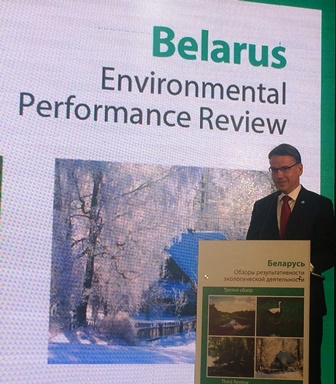
Increased municipal and industrial waste, the continued use of asbestos, the need for effective radiation monitoring at the Ostrovets nuclear power plant and improved conditions for public participation are some of the most pressing environmental sustainability issues in Belarus. These are the main findings of the third Environmental Performance Review (EPR) of Belarus undertaken by UNECE.
The review was launched in Minsk by the Prime Minister of Belarus, Andrey Kobyakov, and UNECE Executive Secretary, Christian Friis Bach, on 2 June 2016.
The Review also highlights progress in improving the state of the environment in Belarus. Between 2005 and 2014, sulphur dioxide emissions contracted by almost a third — from 75,000 to 51,000 tons. The Government managed to stabilize and, in recent years, even reverse, the impact of the transport sector on air pollution. Compared with 2009, emissions of air pollutants from transport in 2013 have declined by some 20 per cent (from 1.14 million to 0.93 million tons). These developments are particularly significant because they are occurring against the backdrop of a sharp increase in the vehicle fleet.
Between 2005 and 2014 the country achieved an 11.5 per cent reduction in the total water abstraction, largely owing to a major decrease in household water use following the introduction of water metering and water charges. Per capita water use dropped dramatically, from 210 litres per day in 2005 to 137 in 2014, with the volume of total wastewater discharges similarly showing an important decrease for the same period (18 per cent).
With regard to biodiversity, the country increased the share of specially protected natural areas from 7.7 per cent of total land area in 2009 to 8.7 per cent in 2015. Since 2005, nine new Ramsar sites were designated and, starting in 2015, a ban on spring hunting of waterfowl was introduced in 32 wetland areas. The country also launched a system for monitoring alien and invasive plant species, and a national ecological network is under development.
Significant achievements in policy and legislation include the integration of green economy principles in the National Strategy for Sustainable Socioeconomic Development and the introduction of integrated environmental permitting and a river basin management approach. A particularly positive element has been the stability of the national environmental authority, which, among others, has facilitated the integration of environmental considerations into sectoral policies and legislation.
Belarus still faces a number of challenges. Along with notable growth in industrial production between 2005 and 2014, at almost 63 per cent, industrial waste generation increased by 51 per cent. While management of industrial waste is well organized at the level of generation and recovery, disposal methods lag behind international practice, especially for sites storing waste generated in large volumes in the past. Developing a hotspot list of industrial waste sites and involving international donors in their rehabilitation are among actions recommended by the EPR.
Another key area of concern is the use of asbestos. Belarus reports high levels of asbestos use, with an average of 1.86 kilograms per capita annually for the period 2001–2012. Two enterprises producing asbestos-containing materials are located in the country, but no data on asbestos concentrations in the environment (air and soil) of the surrounding areas is available. Similarly, although asbestos is still used in building construction, data on asbestos in houses is lacking. Specific diseases related to asbestos (asbestosis and mesothelioma) are not registered. The Review recommends the Government to develop and implement measures to reduce the use of asbestos using WHO guidelines.
A 2,400 megawatt nuclear power plant is under construction in Ostrovets, and its first reactor is expected to be operational in 2019. It is important to ensure the new plant complies with international standards in order to reduce environmental and health risks. The Review stresses that the authorities have to bear the associated costs of the installation, such as enhanced radiation monitoring, development of safety programmes and emergency action plans, and ensuring the availability of medication (iodine pills).
Last, but not least, the Review underscores the need to ensure effective public participation in environmental decision-making by further improving the conditions related to the establishment and operation of environmental non-governmental organizations, introducing procedures for public participation in the development of strategic documents and legislation relating to the environment and removing the remaining barriers to access to justice on environmental matters.
The Review was financially supported by the German Federal Ministry for Environment, Nature Conservation, Building and Nuclear Safety and the German Federal Environment Agency with funds from the Advisory Assistance Programme and by the Governments of Norway and Switzerland. The Ministry of Social Affairs, Health and Women’s Rights of France and the United Nations Environment Programme delegated experts for the review. The United Nations Development Programme office in Belarus provided organizational support.
The Review (in English and Russian) and its Highlights (English only) are available online from http://www.unece.org/index.php?id=41226.
For more information contact:
Mr. Antoine Nunes
Programme Manager
Environmental Performance Reviews
E-mail: [email protected]